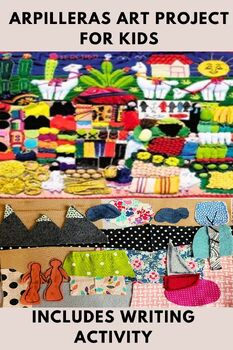Hispanic Heritage Arpilleras Fabric Art Project Lesson 4th 5th 6th grade
- PDF
Also included in
- These lessons are a good resource for Hispanic Heritage and multicultural education. This bundle of three art lessons offer the students an opportunity to discuss culture and create a beautiful piece of art in the style discussed. Inside This Lesson Bundle: Amate Bark Paintings, Arpilleras Fabric APrice $7.00Original Price $9.00Save $2.00
Description
In this lesson, students will learn about the tradition of arpilleras, a style of fabric art that originated in Latin America as a form of protest and storytelling. They'll learn about the history and significance of these beautiful works of art, and then create their own arpilleras using fabric scraps, thread, and other materials.
Here are four ways you can incorporate this lesson into your elementary classroom:
- History lesson: Use the arpilleras lesson as an opportunity to teach your students about the history of Latin America, including topics such as colonization, the fight for independence, and the struggles faced by indigenous peoples and marginalized communities.
- Language arts: Have your students write short stories or essays inspired by their arpilleras, exploring themes such as social justice, community, and identity.
- Social studies: Connect the arpilleras lesson to current events by discussing issues such as immigration, climate change, and political activism in Latin America and beyond.
- Math and geometry: Use the lesson to explore shapes, patterns, and symmetry, as students create their arpilleras using geometric shapes and repeating patterns.
This art lesson is a wonderful way to engage your students in Hispanic Heritage Month and to encourage them to explore new cultures and traditions through art.
Arpilleras Fabric Art
Outcomes: color, balance, pattern, texture
**This lesson is a good resource for Hispanic Heritage and multicultural education**
What you will find inside the lesson:
- Teacher prompts for you to read as you give the lesson making it EASY to teach!
- Glossary of art terms
- Brief discussion of each topic that is simple and easy to comprehend
- Questions to ask the students about the art
- Step by step DETAILED instructions for an art project with FULL COLOR pictures.
- INSTRUCTIONS ON HOW TO CONFORM THIS LESSON TO COMMON CORE STANDARDS
- Art work to show as examples
- Comprehension questions Worksheet for you to extend the learning that feature key facts about each art project
- Word search and/or coloring page for fast finishers
- Worksheet where students have the opportunity to give you feedback about the projects
Make sure to click the GREEN STAR near my store name so that you can stay in touch with my store. I create new lessons every week.






